Physical Address
304 North Cardinal St.
Dorchester Center, MA 02124
Physical Address
304 North Cardinal St.
Dorchester Center, MA 02124
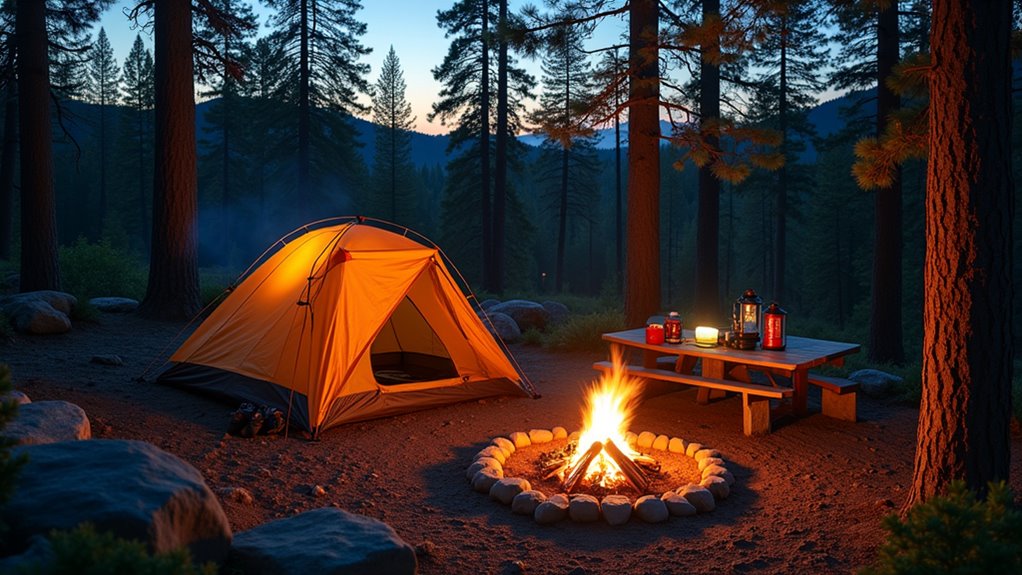
Journey into unforgettable camping adventures while mastering essential safety secrets that separate wilderness experts from weekend warriors.
You’ve probably imagined the perfect camping trip—crackling campfire, starlit skies, and complete disconnect from daily stress. But here’s what separates memorable adventures from potential disasters: knowing how to balance enjoyment with smart safety practices. Whether you’re planning your first overnight or you’re a seasoned camper looking to refine your approach, there are critical steps that’ll transform your outdoor experience from simply surviving to truly thriving in nature’s playground.

Before you head into the wilderness, you’ll need the right gear to keep yourself safe and comfortable throughout your camping adventure. Start with a quality tent that’s weatherproof and properly sized for your group. Pack a reliable sleeping bag rated for expected temperatures, plus a sleeping pad for insulation and comfort.
Don’t forget essential safety items: a first aid kit, flashlight or headlamp with extra batteries, and a whistle for emergencies. Bring a portable water filter or purification tablets to guarantee safe drinking water.
Pack weather-appropriate clothing, including rain gear and extra layers.
A camping stove with fuel provides safe cooking options, while a cooler keeps food fresh. Finally, include a multi-tool, rope, and waterproof matches for various needs. Consider planning family camping activities to make the most of your outdoor adventure together.
Once you’ve gathered your gear, selecting the right campsite becomes your next critical decision for a safe and enjoyable outdoor experience. Look for level ground that’s naturally cleared of rocks and debris.
After gathering your essential gear, your campsite selection becomes the foundation for outdoor safety and comfort on level, debris-free terrain.
You’ll want higher elevation to avoid water pooling during rain, but stay away from ridgetops where lightning strikes.
Choose spots protected from prevailing winds, ideally with natural windbreaks like trees or rock formations. Avoid camping directly under dead branches or unstable trees that could fall.
Water access is essential, but don’t camp too close to rivers or lakes where flash floods pose risks.
Check for signs of wildlife activity like tracks or droppings.
Finally, ensure you’re camping in designated areas where permitted, respecting local regulations and Leave No Trace principles.
Consider these 15 factors comprehensively to ensure you’ve evaluated all aspects of campsite safety and comfort before setting up your tent.
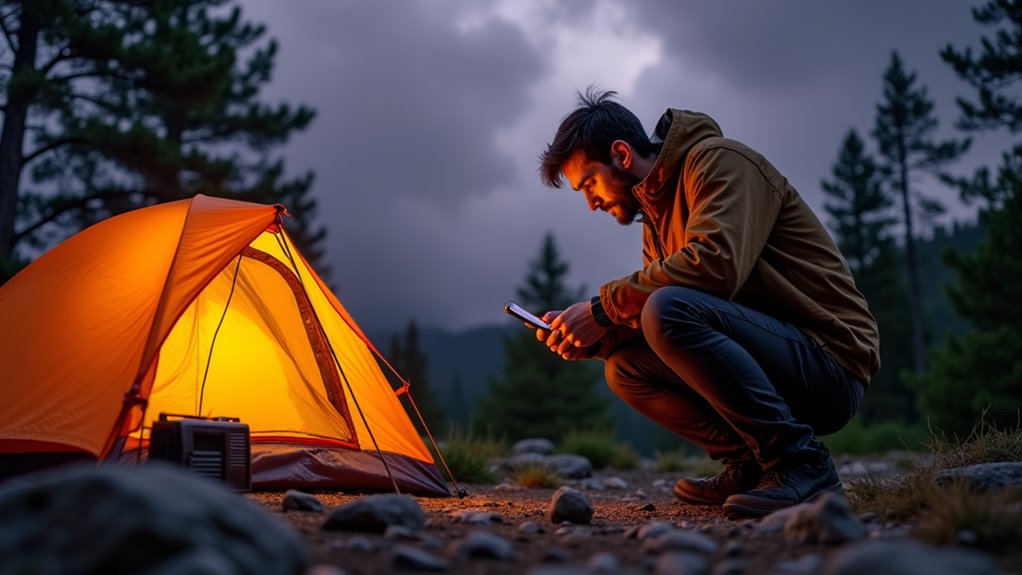
After selecting your ideal campsite, understanding weather patterns becomes your lifeline for outdoor safety. Check forecasts before departure and monitor conditions throughout your trip using weather apps or portable radios.
Pack gear for unexpected changes—rain jackets, warm layers, and waterproof covers for equipment.
Watch for warning signs like sudden temperature drops, darkening clouds, or shifting wind patterns. Lightning poses serious danger, so seek shelter in vehicles or substantial buildings, never under trees.
If storms approach, secure loose items and move to lower ground away from ridges.
Create backup plans for severe weather scenarios. Know evacuation routes and have emergency contacts readily available.
Temperature extremes require different strategies—stay hydrated in heat, layer clothing in cold.
Weather awareness isn’t paranoia; it’s smart camping that keeps adventures enjoyable and safe. Consider how your camping style influences your weather preparation needs, as car campers have different gear requirements than backpackers or RV enthusiasts.
While proper weather preparation protects you from nature’s elements, smart food handling shields you from invisible dangers that can quickly ruin your camping experience. Keep perishables in coolers with plenty of ice, maintaining temperatures below 40°F.
Smart food handling protects campers from invisible dangers that can instantly transform an adventure into a nightmare experience.
Store raw meat separately from other foods to prevent cross-contamination.
When cooking, use a camp stove rather than open flames for better temperature control. Cook meat to proper internal temperatures—165°F for poultry, 160°F for ground meat, and 145°F for whole cuts.
Clean your hands and utensils frequently with soap or sanitizer.
Never leave food unattended, as wildlife can appear quickly. Store all food, including snacks and toiletries, in bear-proof containers or hang them at least 12 feet high and 6 feet from tree trunks.
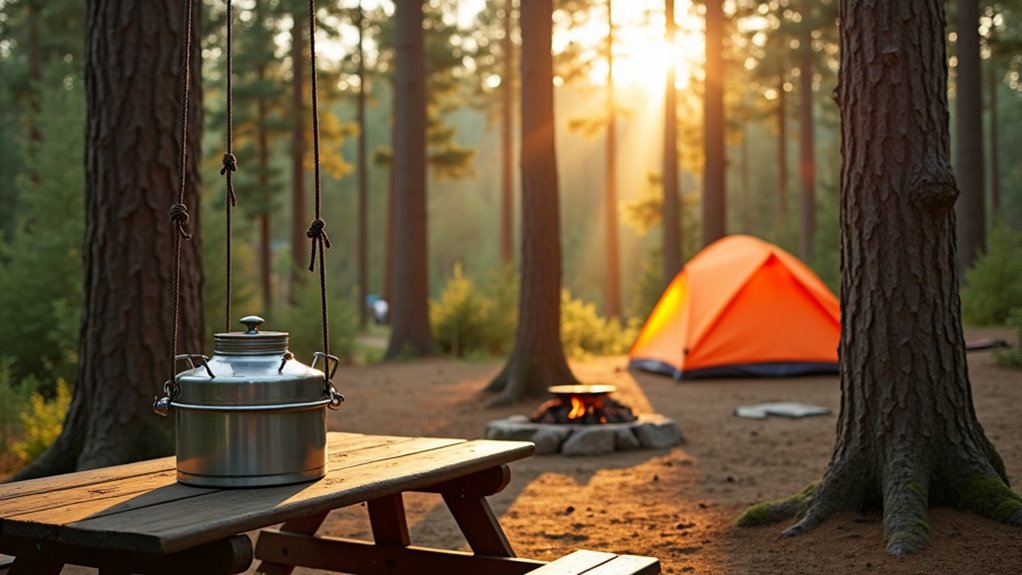
Though proper food storage helps deter animals, you’ll need additional strategies to handle unexpected wildlife encounters safely. Make noise while hiking to avoid surprising animals, especially around blind corners or dense vegetation. Keep your campsite clean and never feed wildlife, as this creates dangerous dependencies and aggressive behavior.
If you encounter a bear, don’t run. Make yourself appear larger, back away slowly, and speak calmly.
For mountain lions, maintain eye contact and throw objects if necessary.
Most snakes will retreat if given space, so watch where you step and use a flashlight at night.
Store toiletries and scented items with your food, as animals are attracted to these smells.
Consider carrying bear spray in areas with large predators, and always follow local wildlife guidelines for your specific camping location. High-altitude environments like glacier climbing areas present unique wildlife challenges due to unpredictable weather conditions and limited escape routes.
Proper fire management protects both you and the environment while ensuring your camping experience remains enjoyable. Before lighting any fire, check local regulations and fire restrictions.
Choose established fire rings when available, or create a safe fire pit by clearing a 10-foot radius of flammable materials down to bare soil.
Keep your fire small and manageable. Never leave it unattended, even briefly.
Have water, dirt, or sand nearby for quick extinguishing.
When you’re ready to leave, pour water over the ashes, stir them with a shovel, then add more water. The ashes should be cold to touch before you depart.
Store firewood away from your fire pit and never burn trash, treated wood, or green branches that create excessive smoke.
For tent camping beginners, mastering these fire safety fundamentals will help ensure your outdoor adventures are both memorable and secure.
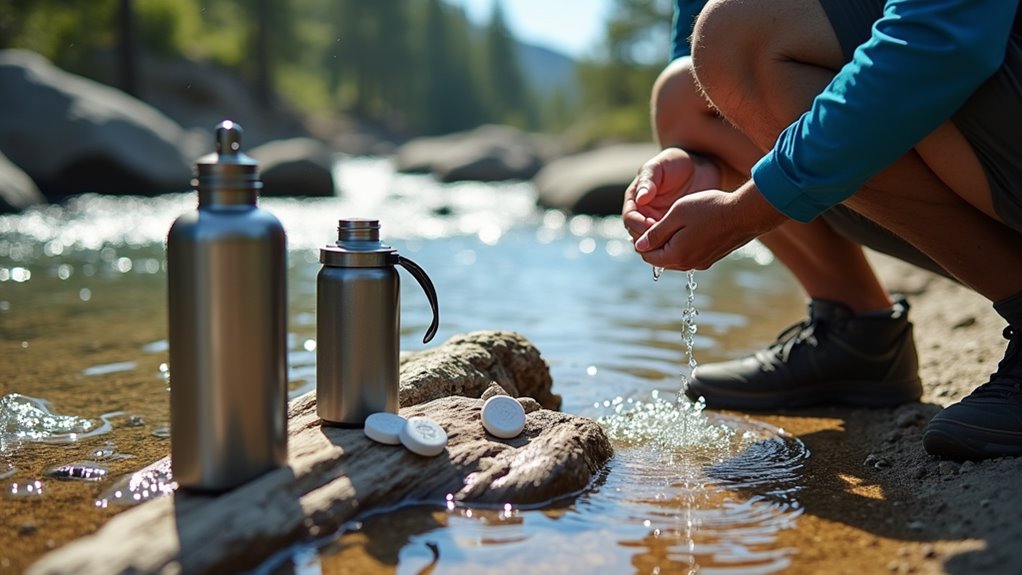
Since clean water is essential for survival, you’ll need to secure a safe drinking supply before heading into the wilderness. Pack more water than you think you’ll need, or bring reliable purification methods.
Boiling water for three minutes kills most harmful bacteria and viruses. Portable water filters remove sediment and many contaminants, while UV sterilizers neutralize microorganisms quickly. Water purification tablets work as backup options.
Never drink directly from streams, lakes, or rivers without treatment. Even crystal-clear mountain water can harbor dangerous parasites like giardia.
Test your purification equipment before your trip.
Store treated water in clean containers and mark them clearly. If you’re collecting water from natural sources, choose flowing water over stagnant pools whenever possible.
Winter camping presents additional challenges, as freezing temperatures can affect both your water sources and purification equipment performance.
When accidents happen in remote areas, you’ll become your own first responder until help arrives. Pack a thorough first aid kit with bandages, antiseptic, pain relievers, tweezers, and any personal medications. Learn basic skills like wound cleaning, splinting, and recognizing signs of hypothermia or heat exhaustion before your trip.
Always inform someone of your camping location and expected return date. Carry emergency communication devices like a satellite messenger or personal locator beacon for areas without cell service. Know the nearest hospital’s location and emergency services contact information.
Create an emergency action plan covering evacuation routes and meeting points. Practice using your gear at home so you’re confident during actual emergencies. Remember, prevention beats treatment – staying alert and making smart decisions prevents most camping accidents.
Having the right essential gear can make the difference between a minor inconvenience and a serious emergency during your wild camping adventure.
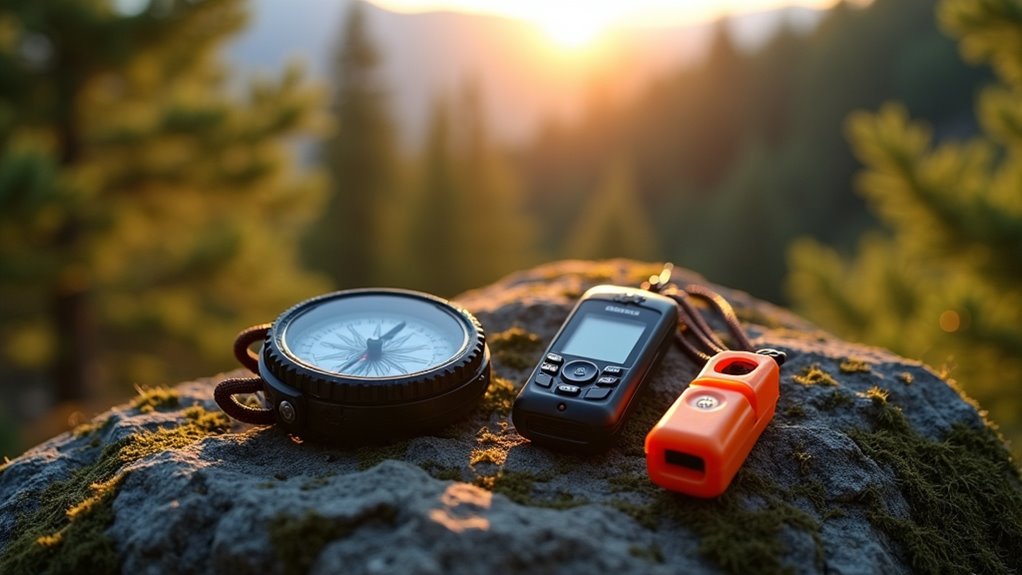
Getting lost in the wilderness can quickly turn a fun camping trip into a dangerous situation, making reliable navigation and communication tools your lifeline to safety and peace of mind.
Always carry a detailed topographic map and compass as your primary navigation tools – they don’t rely on batteries or signal strength. Learn basic compass reading and triangulation techniques before your trip.
GPS devices and smartphone apps provide excellent backup navigation, but download offline maps since cell coverage isn’t guaranteed in remote areas.
For communication, consider a satellite communicator or personal locator beacon for emergencies. Two-way radios work well for short-range group communication.
Keep backup batteries for all electronic devices, and inform someone of your planned route and expected return time before departing.
Remember that proper camping preparation extends beyond navigation tools to include researching weather conditions, trail difficulty, and potential hazards specific to your chosen destination.
While you’re enjoying nature’s beauty, you have a responsibility to preserve it for future generations by following Leave No Trace principles.
Nature’s pristine wilderness depends on each visitor’s commitment to responsible outdoor ethics and environmental stewardship.
Plan ahead and travel on durable surfaces like established trails and campsites.
Pack out all trash, leftover food, and litter—leave your campsite cleaner than you found it.
Dispose of waste properly by digging catholes 6-8 inches deep and 200 feet from water sources.
Leave natural objects where you find them; don’t take rocks, plants, or artifacts as souvenirs.
Minimize campfire impacts by using established fire rings and completely extinguishing fires.
Respect wildlife by observing from a distance and storing food securely.
Be considerate of other visitors by keeping noise levels down and yielding trail space appropriately.
These principles apply whether you’re camping near world-class hiking trails or exploring local wilderness areas.
You’ll create unforgettable memories when you combine proper preparation with responsible outdoor practices. Take Sarah’s experience last summer—she researched weather patterns, packed emergency supplies, and followed Leave No Trace principles during her week-long Yellowstone trip. When unexpected storms hit, she stayed safe and comfortable because she’d prepared thoroughly. Her careful planning didn’t limit her adventure; it enhanced it. Follow these guidelines, and you’ll enjoy camping’s rewards while protecting yourself and nature.